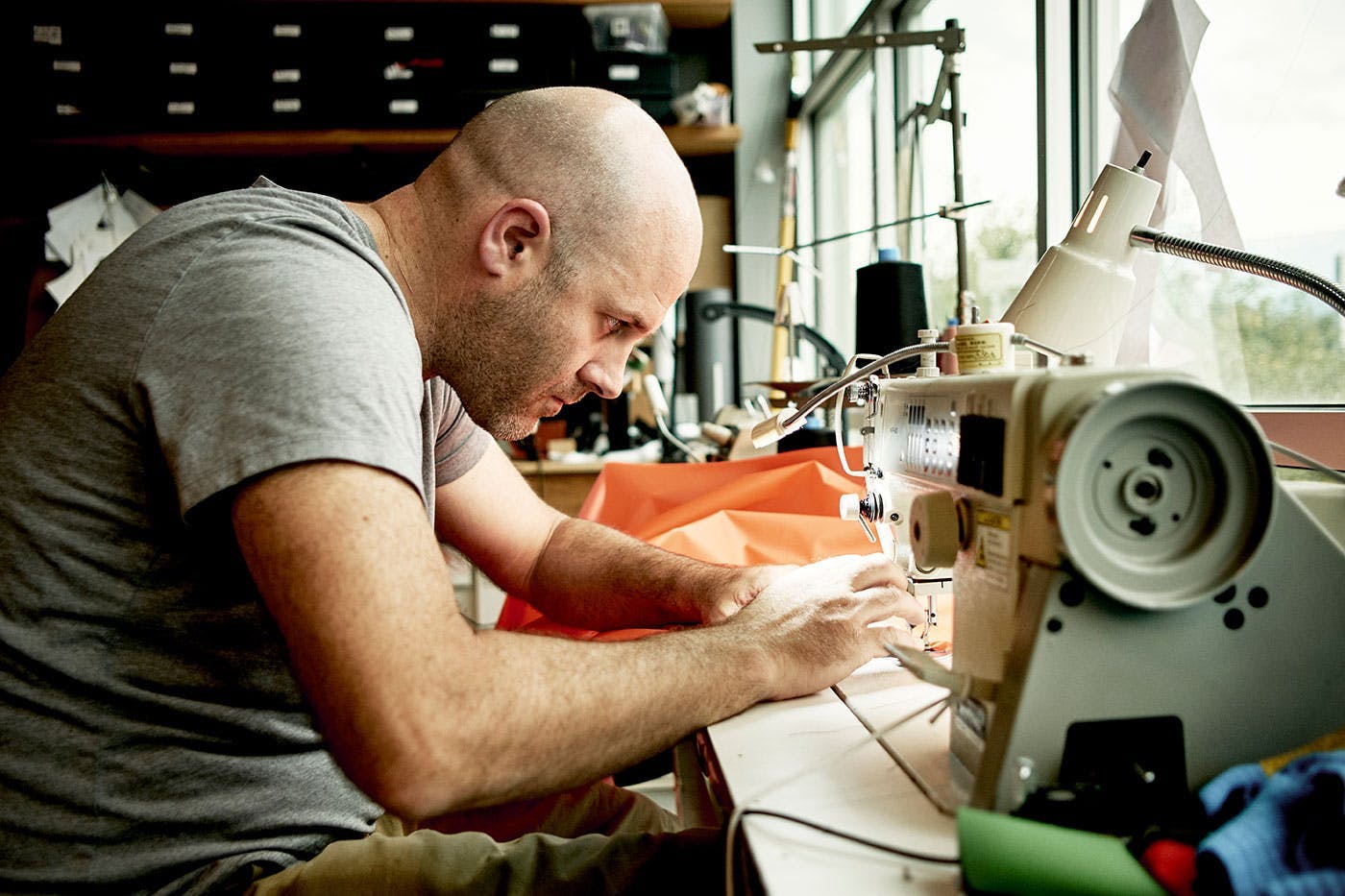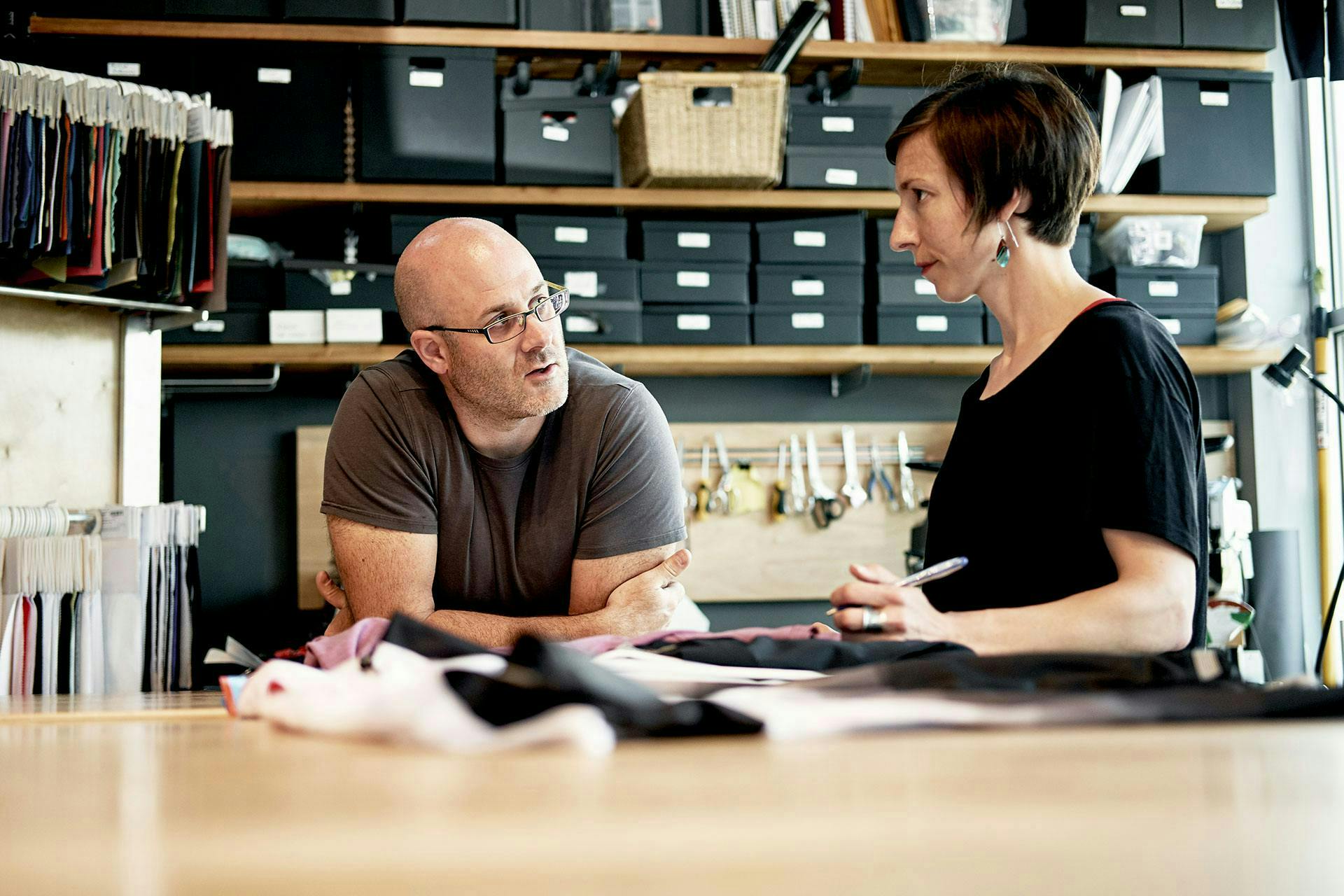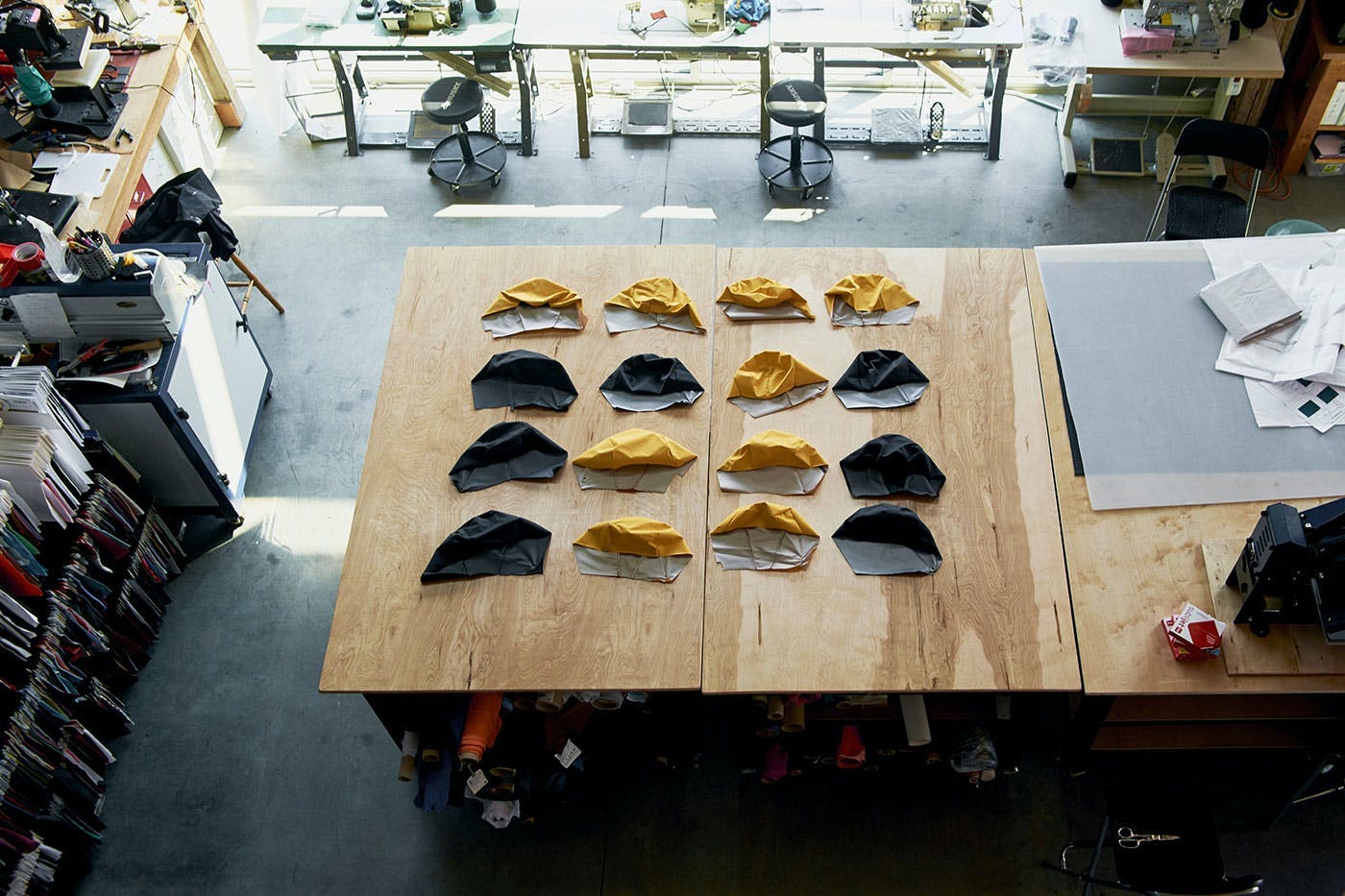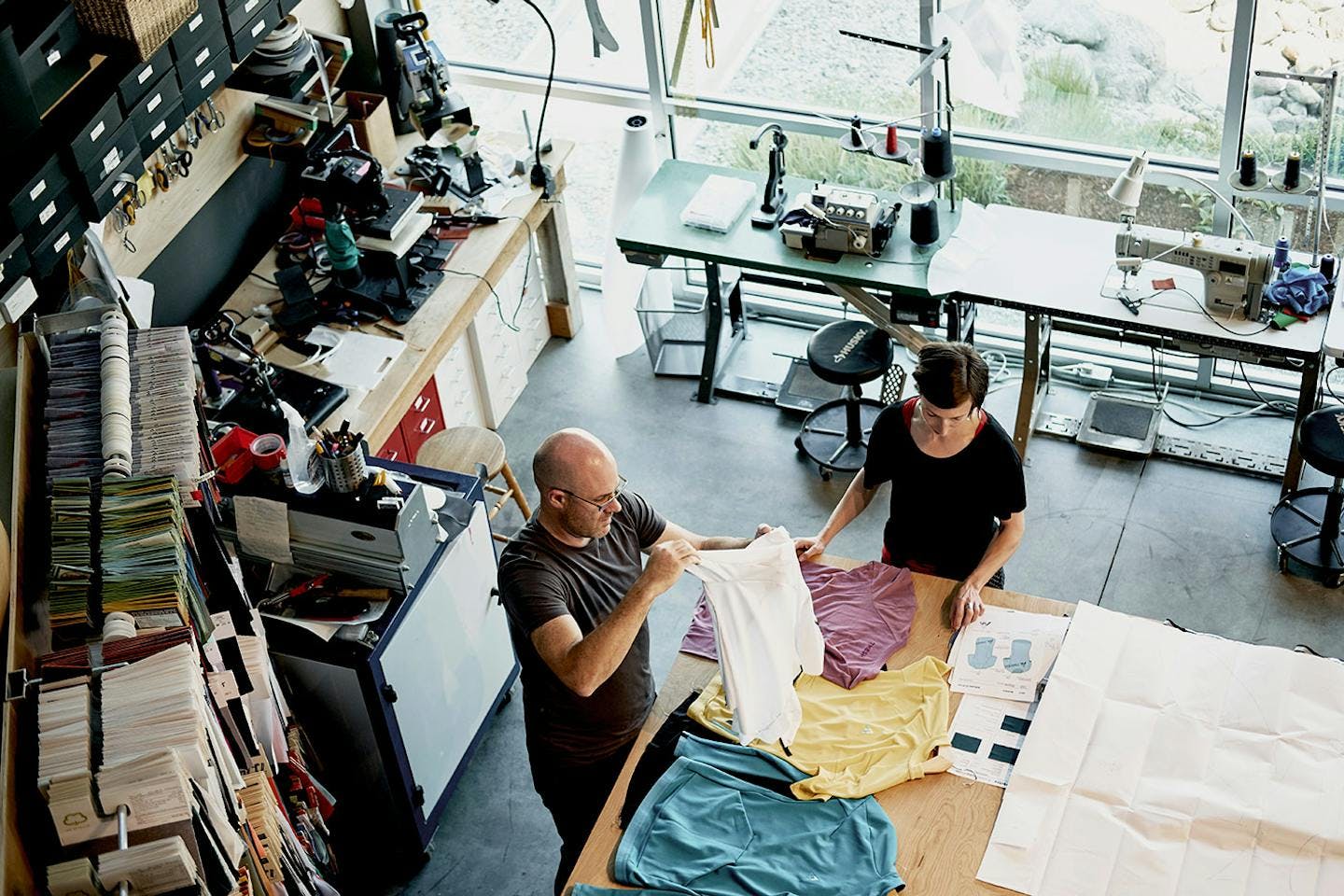Product & Process With 7mesh VP of R&D, Ian Martin
Words: Pete Harrington
Photos: Jonas Kullman
If you ever feel the need to test out the waterproof qualities of a newly-purchased jacket by jumping fully-clothed into the shower, then have hope – you are not alone. You are in fact only following in the footsteps of our VP of R&D, Ian Martin. But as it turns out, Ian was only following in the footsteps of another, possibly even crazier guy; one he would come to work with during his ten years as a product designer at Arc’teryx.
We asked Pete Harrington from Where Beagles Dare! to help tell our design story by interviewing Ian about his early influences, Arc’teryx, his self-confessed strange approach to design, and why keeping the creative process in-house always makes for a better product.
What led to your career in design?
My family is all kinds of engineers, architects, and artists for the most part; all pretty artsy and creative. I grew up in a very isolated place without the opportunity to get decent equipment. And then in 1994, I discovered Mountain Equipment Co-op, which is like the REI of Canada. You could mail order stuff, so at a very young age, I was using money from my paper route to buy a better Gore-Tex jacket to keep me warm and dry.
It’s fair to say that from when I was a kid, it wouldn’t matter what my family got me for Christmas, as long as it had Gore in it.
Paper routes are killer.
Very cold and very wet. I remember wearing this jacket and thinking, “Oh yeah, I got the good jacket now,” and being very disappointed because it was a two layer with a hung liner. It was expensive for me at the time but in the big scheme of things, not the most premium jacket. I called the Co-op with all these questions, and no one in customer service could answer them – this is as a 13-year-old or 14-year-old.
After the jacket proved less than impervious?
Yeah, it wasn’t beading. When I first got it, I was so excited. I was in the shower with it on kind of thing, as a little kid. And my mom was just like, “You’ve got serious problems, what is wrong with you?” And I was proud because I had saved up a lot of pocket money to buy it, whatever it was. And we were doing all these crazy winter camping trips at the time. Anyway, long story short, as with all early, inexpensive GORE-TEX, very quickly the membrane contaminated and the face stopped beading, so I’d be stuck trying to revive it with an iron to get the DWR to be improved. There was no internet, so all I could do was read from catalogues, and call customer service at the Co-op.
And they ended up going, “We can’t answer your questions. Let us put you through to someone who can.” I remember talking to this guy on the phone, and I remember thinking that this guy knows a lot, he’s really kind of crazy – he’s a crazy dude. Anyway, years later, when I was at Arc’teryx, I realised that Mike Blenkarn, the guy I talked to, was one of the guys I was working with, and he used to be at the Co-op way back when.

It’s a small world.
It just clicked one day, and I was like, I talked to you in 1995!
“Question Boy? You’re that kid from Newfoundland!”
It was super funny, and yeah, he did remember me, thankfully. Anyway, he’s one of the guys who I learned a lot from at Arc’teryx, and, incidentally, the man who invented the urethane coated waterproof zipper.
The one that’s now on every waterproof jacket?
Yeah, that was an Arc’teryx thing. They commercialised that with a vendor. It was Mike’s concept, and then Arc’teryx ran with it. I’m not sure of the exact history, but when they launched their first Gore jacket, that was one of the things they went with. But it took a lot of energy to get that commercialised – that’s a story in its own right.
Mike’s a straight talker though, very blunt. He uses a lot of analogies and stuff when he talks. As a teenager, I was probably wondering what he was talking about.
And fascinated in equal measure?
For sure. I distinctly remember him saying, “Why’d you buy that jacket?” No sympathy for a kid who just spent his life savings to buy it. “Why’d you buy that one? The GORE-TEX leaks. It’s horrible shit. You should’ve bought this one.” He’s pretty blunt. I remember at the time feeling a bit sorry for myself.
So then I started making stuff sacks and bags and whatever I could, although getting fabric was really hard. There was a company in Oregon and one in Calgary who used to buy fabric in whatever colour they had from companies in the outdoor industry and resell it to consumers to make stuff at home. And you’d ask, “What you got in stock?” And they’d tell you all these descriptions. And of course, you didn’t have any idea what they were, only, “It’s how much a metre?” So we ended up doing that, and then in high school, I started a little business with a buddy of mine. We used to make canoe yokes for tripping, and tank bags and chalk bags for rock climbing. I also made my first rock climbing harness and climbed in it for years after that.
That’s ultimate faith in your handiwork.
It was safe! I climbed in that thing for quite a while. And then finally – I think I was at a climbing gym somewhere – someone said, “You can’t climb on that.” So I thought, ok, maybe it’s time to shelve it. But I was still always making stuff.
I ended up going to Ontario for school. At the time, I didn’t know about industrial design; didn’t realize that was a career path. I thought about doing architecture because my grandfather was an architect, and it seemed like a cool thing to do, but there were no programs locally.
I’d also done business school for a year, and I hated it. Well, I didn’t hate the courses and the concepts, I just didn’t have anything in common with the people there.
They weren’t coming from a product background?
Exactly, and I know this is going to sound tutti frutti or whatever, but I had a hard time liking my classmates. They were all so focused on just business and making money, and you know, there’s nothing wrong with making money. It was just that their approach was wrong.

And the product has to come first, right?
Totally, and I just wasn’t into their money-first mentality. So eventually I moved out to Ontario and took degrees in GIS mapping and geography.
While I was there, I built a load of stuff, with mixed success. I’d bought a book on building cedar strip kayaks. They’re amazing things. You cut little strips, and you put them all together with cove and beads and you fibreglass over them to build the most beautiful boats. So my wife and I decided to build a kayak paddle from the book. Of course, it went horribly wrong. It was the worst paddle ever. So we looked at each other and thought, well, we should probably build a boat then; that’d be way easier! I don’t know what we were thinking. A boat is a thousand times harder. But, ignorance is bliss. You can just jump right in.
So we bought a bunch of cedar and loaded the stuff into the van. I can still remember the van pulling out, and wondering what the hell we were doing. We ended up setting up a little shop in the basement of our home, making these boats for the next year or so while we completed our last year of university, all the time not knowing if they were going to fit out of the house.
They’re not still stuck there, are they?
We had to remove a window, but we got them out.
Thank goodness for ignorance.
It’s brilliant. I say that whenever we have somebody new come on to 7mesh, I’m like, “Now is your golden time, before you know what, in theory, can or cannot be done, this is the time you can have a moment of self-discovery and not even know you’re breaking rules that exist.”
So when was your moment of self-discovery? When did you follow the thread of making things and realise that it could lead to a career?
One day in 2001, I was chatting with my friend Calum [now VP of Operations at 7mesh], who was working as a junior accounting person at Arc’teryx. I said, “Well, are there any jobs there? That sounds interesting.” And he replied, “I don’t know. Let me ask some people.” This would’ve been about 7 or 8 years after they first started, post the Gore jacket launch.
But it was still fundamentally a small company?
Oh yes, a small company. Everyone in the same room. Anyway, I printed him a copy of my resume, which was complete garbage…
With a photo of a boat on it?
I wish. Anyway, I got a job in marketing, but it was mind-numbingly dull. I had to create an access database of all the dealers in North America, but the internet was too shitty and unstable to do that kind of research; now, it would be so easy. I think the job was only supposed to last three months, and I think I continued it with a bunch of add-on projects for six months.
One day, I arrived at work with my cedar strip boats on the roof. There were two floors, downstairs with the office and an upstairs with the seven or eight people that worked in design. They saw my boats out of the window, and asked, “Who owns those things? Those are awesome!” So that was an instant friend-builder, and I got to meet to meet a lot of people. They showed me some things, and a couple of other people showed me some stuff, and I just started building things. And man, Arc’teryx was growing.

Pretty soon after that, I managed to get a good product developer position, which is someone who looked at what was being made, recorded all the information, and then helped the factory engage on it. Up until then, the designers recorded the information and then they were the ones who would sit down with the factory and show them. My role was more of a ‘how do we help them along’ position. I did that for two years, and we went from not having anything set up to designing the whole process of how it was going to work, to integrating with a new ERP system that they designed from the ground up.
I learned a ton from it, but after two years of that I was feeling the lack of actually making stuff, so I said, “Well, what if I worked on a climbing harness?” I think nobody else had time to work on climbing harnesses right then; it’s high stress and low reward because if you make a mistake, someone dies. People hit the ground. Nobody wants to put their hand up and make that. There were a few internal advocates who wanted to see the harness program continue, but everyone was slammed making all the other products. I was lucky enough to be in the right place at the right time.
Not many people realise that Arc’teryx was originally a climbing harness business. They went into backpacks and did quite well, but it was still a small business relative to how big everything got later on. If you talk to people internally, harnesses were Arc’teryx’s heritage, and that’s where people were most proud; although they hadn’t touched their earlier designs in almost ten years. Again, ignorance is bliss, so I jumped into that with ideas (some good and some not so good) and experience of making my own, but not much else. In hindsight, it was a lofty thing to jump into, but I was lucky to have many great mentors to guide me at the time.
How did your time at Arc’teryx inform your design process?
I’m a firm believer in an iterative process. We used to have a mantra at Arc’teryx: design, materials construction. Imagine a Venn diagram where innovation is in the middle, and then it’s design, materials, construction, and they’d overlap, you know? And it was like overlapping circles. I think that’s somewhat true, but those are just key elements. It’s great that you can talk about those things externally, but it’s not about that. There’s always a goal, but for the most part, it’s about going through the process of trial and error. I mean, you can say it’s scientific because you have a hypothesis, and you’re working towards trying to solve that. But in reality, it’s more craftsmanship than anything else.
And how does approach of the cycling apparel industry contrast with that?
Most of the industry will draw a picture of a garment and say what they want the length to be and what the fabric is etc. It will literally be a drawing of a garment – front, back, maybe a side, and that’s it. So the designer will say, “Oh, I want the logo here, and I want this to be a single line of stitching here, and I want the chest measurement to be 40 from here, and I want the collar to be this kind of trim.”
Arguably, that’s not design, that’s positioning.
Unfortunately, that is design for many or most brands in the apparel industry, including anything bike. Then they have marketing people to make it sound like they made it. Well, in most cases, they didn’t. They ordered it. And even companies that do design as we understand it, they might draw the tech pack and pass that off to the pattern maker, but along the way, it loses something from what they think they should make.
Every time I create a garment, I think, “We’re going to build this, and it’s going to work that way.” So I’ll design one, pattern it myself on the table downstairs, and cut and sew it; but, as soon as I build it, I’ll think, “Oh, that’s rubbish; this doesn’t work at all.”
You won’t draw it up; you’ll build one in-house yourself?
At Arc’teryx, I think because we had our own factory, it pushed us to do it this way, but only because no one in the company at the time had classical training. So we ended up with an intensive, in-house mindset which informs a ton of stuff, like for example, which fabrics are going to be good, which ones are going to bad, and how they’re going to integrate together. And with that approach, you get very good at your craft. It’s like any of these custom frame builders out there, building beautiful bikes from merely looking at the customer, and knowing what to make.

At 7mesh, we’re trying to foster the growth of vertical design, and when I say design, it’s a broad term. Ultimately, you have to focus on solving something, and that needs to come from the person who’s making the product; we can’t lose that input feed.
And the process is iterative; you’re conceptualising something that you would never put on paper if you didn’t have this tie to the materials and how it’s put together. You’d never even think about it that way. When my colleague Conroy and I sit down and go through 100 fabric headers, we both pick the same 7 out of 10. There’s a reason for that because we’re both thinking about it from the same approach.
So really it roots back to what the product is being used for because if you don’t have a connection with the user…
You’re lost from the start.
Then comes the factory, and presumably, another opportunity to max-out what’s possible?
What was invaluable for me at Arc’teryx, was the factory experience. If I don’t know how a factory works, how can I push the limits? You can’t conceptualise what you can or can’t do at a design level if you don’t know what’s currently possible. And you can learn that in books and you can learn that in school, but it comes down to interacting with the factory. And when you go to a factory, it’s like you do the factory tour and you just walk the line, and that’s it. That’s your factory tour.
I guess they’re not great at telling you, “By the way, you do this on the seams, but you know, we can do this….”
They don’t do a lot of that. When we come to them, if you understand what their limitations are, you can push them in some areas, and you know which areas are probably going to be safe and which ones aren’t. And sometimes you get it wrong. We’ve got it wrong a couple of times with products. We’ve done samples one way, and we started to do bulk production, and the factory would say, “We just can’t do it like that” And so you’ve got to set up to teach them a certain way to do it.
So patterning and making samples in-house can help to not only visualise a product, but also offset, or avoid issues down the line?
Absolutely. For the Revelation Jacket, I think Conroy and I went through hood, after hood, after hood, after hood of different pattern concepts to see what was the best. And you try different things but young designers are taught to conceptualise, and so they want to draw a picture of what it is and see it in their mind’s eye. They want to see what that looks like in all its detail, and then they want to make one and have it executed the way they thought about it. And I think that is complete rubbish.
Iterating, then, to get closer and closer to the finished product?
Totally. I’m more of the attitude of let’s make one and know that the first one’s going to be garbage. Accept it. Accept that for the first five, or six, or seven, if it’s something novel and new, and that quite possibly, they’re going to be junk. You might get lucky here or there, but just accept that it’s going to be junk and accept that someone’s going to look at it and have no faith in what you’re doing, and get comfortable with that.
You’ve got to be comfortable with failure because you’re going to fail 99 times out of 100. So let’s fail as many times as we humanly can because that’s going to get us where we need to go.
It’s like a tree. You’re going down many branches, and one branch leads somewhere, and the other ones are just dead ends.
